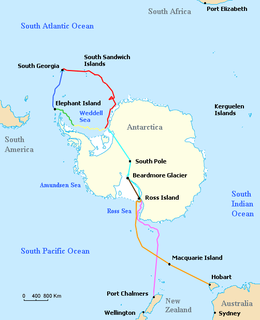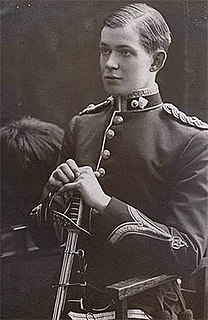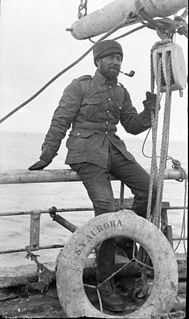
Sir Douglas Mawson OBE FRS FAA was an Australian geologist, Antarctic explorer, and academic. Along with Roald Amundsen, Robert Falcon Scott, and Sir Ernest Shackleton, he was a key expedition leader during the Heroic Age of Antarctic Exploration.

Xavier Guillaume Mertz was a Swiss polar explorer, mountaineer, and skier who took part in the Far Eastern Party, a 1912–1913 component of the Australasian Antarctic Expedition, which claimed his life. Mertz Glacier on the George V Coast in East Antarctica is named after him.

The Australasian Antarctic Expedition was a 1911–1914 expedition headed by Douglas Mawson that explored the largely uncharted Antarctic coast due south of Australia. Mawson had been inspired to lead his own venture by his experiences on Ernest Shackleton's Nimrod expedition in 1907–1909. During its time in Antarctica, the expedition's sledging parties covered around 4,180 kilometres (2,600 mi) of unexplored territory, while its ship, SY Aurora, navigated 2,900 kilometres (1,800 mi) of unmapped coastline. Scientific activities included meteorological measurements, magnetic observations, an expansive oceanographic program, and the collection of many biological and geological samples, including the discovery of the first meteorite found in Antarctica. The expedition was the first to establish and maintain wireless contact between Antarctica and Australia. Another planned innovation – the use of an aircraft – was thwarted by an accident before the expedition sailed. The plane's fuselage was adapted to form a motorised sledge or "air-tractor", but it proved to be of very limited use.

SY Aurora was a 580-ton barque-rigged steam yacht built by Alexander Stephen and Sons Ltd. in Dundee, Scotland, in 1876, for the Dundee Seal and Whale Fishing Company. It was 165 feet (50 m) long with a 30-foot (9.1 m) beam. The hull was made of oak, sheathed with greenheart and lined with fir. The bow was a mass of solid wood reinforced with steel-plate armour. The heavy side frames were braced by two levels of horizontal oak beams. Her primary use was whaling in the northern seas, and she was built sturdily enough to withstand the heavy weather and ice that would be encountered there. That strength proved useful for Antarctic exploration as well and between 1911 and 1917 she made five trips to the continent, both for exploration and rescue missions.

The Ross Sea party was a component of Sir Ernest Shackleton's 1914–1917 Imperial Trans-Antarctic Expedition. Its task was to lay a series of supply depots across the Great Ice Barrier from the Ross Sea to the Beardmore Glacier, along the polar route established by earlier Antarctic expeditions. The expedition's main party, under Shackleton, was to land near Vahsel Bay on the Weddell Sea on the opposite coast of Antarctica, and to march across the continent via the South Pole to the Ross Sea. As the main party would be unable to carry sufficient fuel and supplies for the whole distance, their survival depended on the Ross Sea party setting up supply depots, which would cover the final quarter of their journey.

Edward Frederick Robert "Bob" was an Australian polar explorer with Douglas Mawson's Australasian Antarctic Expedition in 1912 and a soldier with the Royal Australian Engineers during World War I.

Belgrave Edward Sutton Ninnis was an English officer in the Royal Fusiliers and an Antarctic explorer who was a member of Douglas Mawson's 1911 Australasian Antarctic expedition.

John King Davis was an English-born Australian explorer and navigator notable for his work captaining exploration ships in Antarctic waters as well as for establishing meteorological stations on Macquarie Island in the subantarctic and on Willis Island in the Coral Sea.
Cape De la Motte is a prominent cape in George V Land in Antarctica separating Watt Bay and Buchanan Bay. Just to the south, the continental ice surface rises 520 metres (1,700 ft) at Mount Hunt. The cape was charted by the Australasian Antarctic Expedition (1911–14) under Douglas Mawson, who named it for C. P. de la Motte, third officer on the expedition ship Aurora. It has been conjectured that the high land behind this cape is "Point Case", which the United States Exploring Expedition (1838–42) under Lieutenant Charles Wilkes saw from what was called "Disappointment Bay" on January 23, 1840.

The air-tractor sledge was a converted fixed-wing aircraft taken on the 1911–1914 Australasian Antarctic Expedition, the first plane to be taken to the Antarctic.
Sidney Harry Jeffryes was an early Australian wireless telegraphy operator. Trained by Australasian Wireless Co., Ltd., he was initially employed on coastal shipping and established at least one record for distance transmission. But he is best known for his service as the wireless officer at Cape Denison during the second year of the Australasian Antarctic Expedition under the command of explorer Douglas Mawson. His service ended in September 1913, two months prior to the relief of the shore party, when Jeffryes developed symptoms of paranoia and had to be relieved of his duties.
Frederick "Frank" Douglas Fletcher was an Australian sailor, mainly known for his time as chief officer of the SY Aurora during the 1911–1914 Australasian Antarctic expedition, under Captain John King Davis.
Norman Champion Toutcher (1884–1924) was a sailor, mainly known for his time as chief officer of the SY Aurora during the 1911–1914 Australasian Antarctic expedition, under Captain John King Davis.

Frederick Jacob Gillies was a Welsh mariner and engineer. During his early career he trained as an engineer aboard Welsh steamships, before working the India trade routes.

John Hamilton Blair was a Scottish mariner, who was first officer aboard the SY Aurora during the Australasian Antarctic Expedition in 1913–1914. He later served in the Royal Navy during the First World War, where he was awarded the Distinguished Service Cross, as the head of Pangbourne Nautical College, and returned to the Navy during the Second World War.

Percival Gray was an Australian naval officer. During his early career he served on the Worcester and the Archibald Russell, and then joined the New Zealand Shipping Company.

The Far Eastern Party was a sledging component of the 1911–1914 Australasian Antarctic expedition, which investigated the previously unexplored coastal regions of Antarctica west of Cape Adare. Led by Douglas Mawson, the party aimed to explore the area far to the east of their main base in Adélie Land, pushing about 500 miles (800 km) towards Victoria Land. Accompanying Mawson were Belgrave Edward Ninnis, a lieutenant in the Royal Fusiliers, and Swiss ski expert Xavier Mertz; the party used sledge dogs to increase their speed across the ice. Initially they made good progress, crossing two huge glaciers on their route south-east.

Morton Henry Moyes was an Australian Antarctic explorer and naval officer.

Alfred Hodgeman was an Australian architect and cartographer known for his involvement in the Australasian Antarctic expedition.















